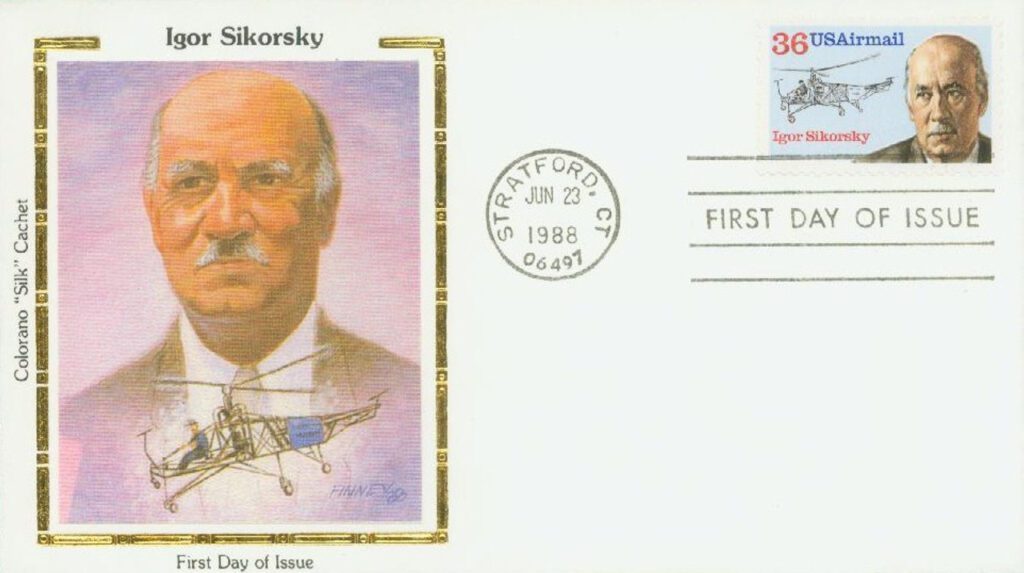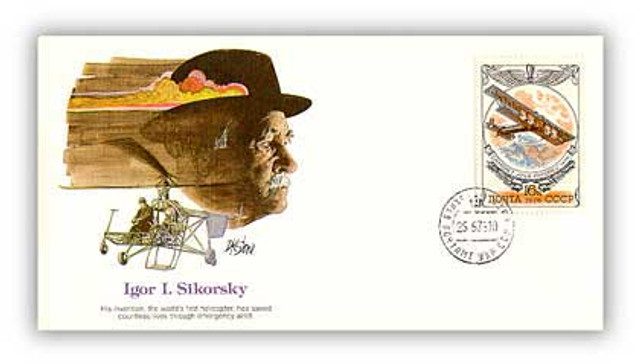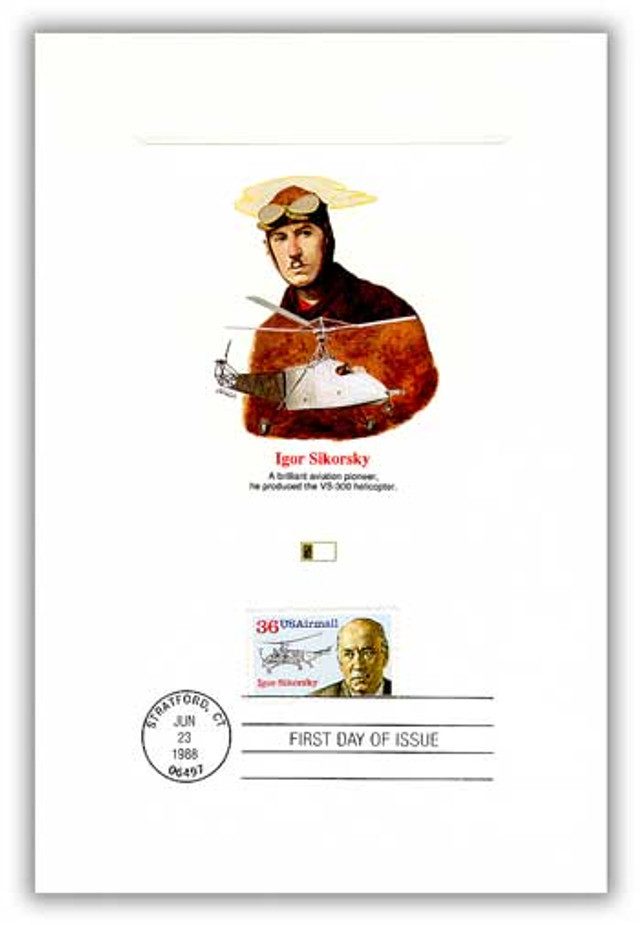On May 24, 1940, Igor Sikorsky successfully flew the first single-rotor helicopter.
Born in Kiev, Russia (now Ukraine) Sikorsky developed an interest in flight at the age of 11, and created a small rubber band powered helicopter by the time he was 12.

Sikorsky attended the St. Petersburg Imperial Russian Naval Academy for three years and later a mechanical college. However, in 1908 he learned of the Wright Brothers’ Flyer and Ferdinand von Zeppelin’s dirigible. He later claimed that, “within 24 hours, I decided to change my life’s work. I would study aviation.”
By May 1909, Sikorsky began designing his first helicopter. However, by that October he realized that with only the parts and knowledge he currently had, it would never fly. Sikorsky then began designing fixed-wing airplanes. After his design won a Russian Army aircraft exhibition, Sikorsky became Chief Engineer of the aircraft division for the Russian Baltic Railroad Car Works. In that role he designed the first four-engine aircraft, the S-21 Russky Vityaz, which he test piloted on May 13, 1913. At the outbreak of World War I, Sikorsky designed the first four-engine bomber.
After the war, Sikorsky believed he’d have more opportunities in America and moved there in March 1919. After working as a teacher and lecturer, he established the Sikorsky Manufacturing Company. With financial backing from composer Sergei Rachmaninoff and others, Sikorsky created one of America’s first twin-engine aircraft. His company then became part of United Aircraft and Transport Corporation (now United Technologies Corporation). With that company, Sikorsky designed and built “flying boats” including the S-42 Clipper that was used for Pan Am transatlantic flights.
Through all this, Sikorsky was still interested in helicopters. In 1931 he filed a patent for a “direct lift aircraft,” which he received four years later. He built his single-engine helicopter, the VS-300, and staged its first tethered flight on September 14, 1939. After that success, he was ready to complete its first free flight on May 24, 1940.
Some mechanics didn’t believe Sikorsky’s helicopter would fly and dubbed it “Igor’s nightmare.” However, during that test flight it successfully flew up to 20 feet off the ground, traveled about 200 feet, backed up, and then landed.
Sikorsky then took what he learned from the VS-300 to design the R-4, which impressed military officials, who ordered 100 of them. In fact, the R-4 was world’s first mass-produced helicopter and one of the first American helicopters used in World War II. It was used to rescue troops in Burma, Alaska, and other areas with challenging terrain. Sikorsky went on to design subsequent models – the R-4 through R-6 – producing over 400 helicopters before the war’s end.
The helicopters Sikorsky’s company went on to produce were even more widely used in the Korean and Vietnam Wars. In fact, Sikorsky helicopters are still used today, including the UH-60 Black Hawk and the Marine One Fleet that transports the president.
| FREE printable This Day in History album pages Download a PDF of today’s article. Get a binder or other supplies to create your This Day in History album. |
Discover what else happened on This Day in History.







Five stars for the articles I vote it.
Very good article! This is the first time I heard that the US, or anyone, used copters during WWII.
Germans were using them during WWII.
Very educational. Thank you.
Great material! You are making a dent in the knowledge base of the “great unwashed.”
***** (I see no place to vote today, so I guess I’ll have to post my preference this way.)
I find it interesting that so many readers are unaware of historical events presented on stamps. Granted that many readers are young, I feel that the world is based more on social interaction with ignorance of wider scope above all. You may find everything on the internet, but you must know what to ask
I love to read the success stories of people who succeed even tho thry strughled. Don’t give up @1st sign of failure. Use your mental eraser to eliminate what does not belong . Success will come if you meet it half way…or even 3/4 of the way
***** = 5 Stars
I had never given any thought as to when was the 1st helicopter flight or ever heard of, or learned about it in history class until today? Thanks.
***** I, too, give this article 5 stars. The helicopter has become such an important and integral “piece of equipment” to our Armed Forces. They are also widely used by Law Enforcement, and Medical Services throughout the country.
“After the war, Sikorsky believed he’d have more opportunities in America and moved there in March 1919.” This is an oddly mild way of saying that Sikorsky, after the disaster of WW1, saw the Bolshevik Revolution for the even greater disaster that it was and, along with hundreds of thousands of talented Russians from all walks of life, decided to emigrate. No?
***** great article
Any thought to publishing a book or booklet of these articles? It would make a wonderful addition to our philatelic bookshelves.
**********!!!
I love my daily history lesson!
pretty cool, i think. i heard – i read – er very old readers digest, before i was born 1942 that he in a aircraft (acft) accident had lost a limb and yet still continued to design and fly acft ( i guess he designed). wow.
I was surprised by the involvement of Rachmaninoff, one of my favorite classical composers/pianists. Upon research this investment occurred near the end of his life. Always something to learn in your articles. Thanks again Mystic.
More great information! Thanks so much.
I know about the UH-60 I used one. I was in the war in. I was iin one doing a war. It can take you back to base safely. After the wa, I flew one as an EMT It’s a very good ship & can a crew of 4 & 2
others. A very good story a the man that invented it.
Thank you. Please do a book with all of the days of history in it
I completely agree that this is indeed a 5-star history lesson !! Learning more about Igor Sikorsky and his invention of the helicopter, piloting its first flight and then relocating to the USA in 1919 to hopefully have a better life … which he absolutely did … was VERY interesting ! He was obviously a brilliant man and helped strengthen our Nation in his endeavors in aircraft development. FIVE stars !!!
Thank you Mr. Snyder, and Mr. Ruffin. I know that The Germans were using helicopters in WWII, I believe one model was known as the ‘Colibri’, a very sleek and ultramodern design, if I may add. And to Mr. Ruffin. The Naval Architect that designed the SS Normandie – the Ship of Light, was a Russian Engineer by the name of Vladimir Yurkovich. He fled together with his family to France, due to the fact the Bolshevik Revolution would lead to his skills not being recognized-Communism. The same reason why my parents, brother, and I immigrated to the US from Cuba, in 1968.
Great article. Made me aware of what a great country this is.